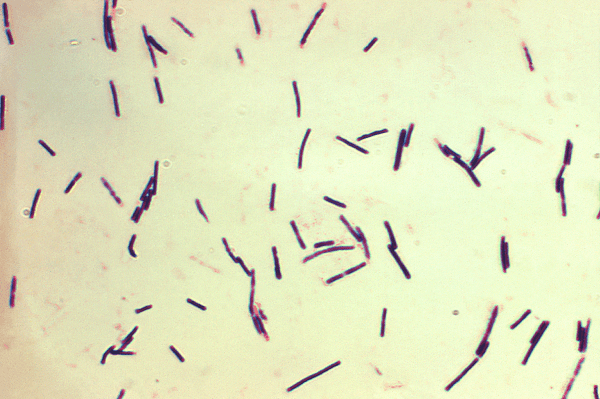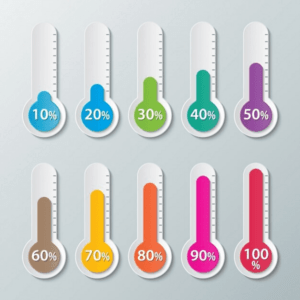Clostridium perfringens- Clostridium perfringens is a species of bacteria that is commonly found in the environment and is also a significant pathogen in various animals, including humans. It is a Gram-positive, anaerobic bacterium, meaning it does not require oxygen to grow and replicate.
Here are some key points about Clostridium perfringens:
- Toxin Production: Clostridium perfringens is known for its ability to produce a variety of toxins, some of which can cause diseases in humans and animals. There are several different types (A, B, C, D, and E) based on the toxins they produce. Types A and C are most commonly associated with human diseases.
- Food Poisoning: Type A strains of Clostridium perfringens are responsible for causing food poisoning, often linked to the consumption of improperly cooked or stored meat and poultry. The bacteria can multiply rapidly in cooked food left at room temperature, producing toxins that can cause gastrointestinal symptoms such as abdominal cramps and diarrhea.
- Gas Gangrene: Infections with certain strains of Clostridium perfringens can lead to a condition known as gas gangrene. This is a serious and potentially life-threatening infection characterized by the rapid destruction of muscle tissue, gas production in the affected area, and severe pain. It is often associated with traumatic injuries, surgical wounds, or deep puncture wounds.
- Necrotizing Enteritis: Clostridium perfringens can also cause a type of necrotizing enteritis, which is an infection and inflammation of the small intestine. This condition can be severe and may require surgery to remove affected tissue.
- Prevention and Treatment: Preventing Clostridium perfringens infections involves proper food handling and cooking, as well as wound care to prevent gas gangrene. Treatment typically involves antibiotics, wound debridement (removal of dead tissue), and supportive care for symptoms.
- Clostridium perfringens in the Environment: Clostridium perfringens is commonly found in soil and the intestinal tracts of animals, including humans. It forms heat-resistant spores that can survive in the environment for long periods.
It’s important to note that not all strains of Clostridium perfringens are harmful, and many are part of the normal microbiota in the human gut. However, under certain conditions, such as when the bacteria multiply rapidly or produce toxins, they can cause diseases. Proper food handling and hygiene practices are essential for preventing foodborne illnesses associated with this bacterium.
What is Clostridium perfringens
Clostridium perfringens is a type of bacteria, specifically a Gram-positive, anaerobic bacterium, which means it does not require oxygen to grow and thrive. It is commonly found in various environments, including soil and the gastrointestinal tracts of humans and animals. Clostridium perfringens is known for its ability to produce a range of toxins and is associated with several different types of infections and diseases.
Here are some key aspects of Clostridium perfringens:
- Toxin Production: This bacterium is notable for its capacity to produce various toxins, and different strains of Clostridium perfringens produce different types of toxins. These toxins can have harmful effects on the human body and contribute to the development of diseases.
- Food Poisoning: One of the most common illnesses caused by Clostridium perfringens is food poisoning. It typically occurs when contaminated food, especially meat and poultry, is consumed. Inadequate cooking or improper food storage can allow the bacteria to multiply and produce toxins in the food, leading to symptoms such as abdominal cramps and diarrhea.
- Gas Gangrene: Some strains of Clostridium perfringens can cause a condition called gas gangrene. Gas gangrene is a severe and potentially life-threatening infection characterized by the rapid destruction of muscle tissue, the production of gas within affected tissues, and intense pain. It is often associated with deep wounds, traumatic injuries, or surgical procedures.
- Necrotizing Enteritis: Clostridium perfringens infections can also lead to necrotizing enteritis, an inflammatory condition of the small intestine. This condition can be serious and may require surgical intervention to remove damaged tissue.
- Environmental Resilience: Clostridium perfringens forms heat-resistant spores, which enable it to survive in the environment for extended periods. These spores can be present in soil and may contaminate food or enter wounds, leading to infections.
Preventing Clostridium perfringens infections typically involves proper food handling, cooking, and storage to prevent foodborne illnesses. For cases of gas gangrene and other infections, treatment often includes antibiotics, wound care, and surgical intervention as necessary.
It’s important to recognize that while Clostridium perfringens can cause diseases under certain conditions, not all strains are harmful, and many are part of the normal microbial community in the human gut.
Who is Required Clostridium perfringens
Clostridium perfringens is not a “who” but rather a “what.” It is a type of bacterium, specifically a species of bacteria. Bacteria are microscopic single-celled organisms, and Clostridium perfringens is one of the many species of bacteria found in the natural environment and in the gastrointestinal tracts of humans and animals.
Clostridium perfringens is known for its ability to produce various toxins and is associated with several types of infections and diseases, as described in previous responses. It is not a person or a living organism with individual characteristics; rather, it is a type of microorganism.
When is Required Clostridium perfringens

Clostridium perfringens is not something that occurs at a specific time or date; it is a type of bacterium that exists in various environments and can potentially cause infections or foodborne illnesses when certain conditions are met.
The presence and activity of Clostridium perfringens depend on factors such as temperature, oxygen levels, and food handling practices. Here are some common situations in which Clostridium perfringens can be relevant:
- Food Poisoning: Clostridium perfringens can cause food poisoning when contaminated food, especially meat and poultry, is left at a temperature range between 40°F (4°C) and 140°F (60°C) for an extended period. Under these conditions, the bacteria can multiply and produce toxins, leading to foodborne illness.
- Wound Infections: In cases of traumatic injuries or surgical procedures, Clostridium perfringens can potentially cause wound infections, particularly gas gangrene. These infections can occur when the bacterium is introduced into deep wounds.
- Environmental Presence: Clostridium perfringens can be found in soil and other environmental sources, and its spores can persist in the environment for extended periods. It is part of the natural microbial community.
So, Clostridium perfringens can be encountered in various situations, but its activity and relevance depend on specific conditions and circumstances. Preventative measures, such as proper food handling and cooking, are often necessary to reduce the risk of foodborne illness associated with this bacterium.
Where is Required Clostridium perfringens
Clostridium perfringens is a type of bacterium that can be found in various environments, including:
- Soil: Clostridium perfringens is commonly present in soil, where it forms spores that allow it to survive in the environment for extended periods.
- Gastrointestinal Tracts: It is a part of the normal microbial community in the gastrointestinal tracts of humans and animals. It can be found in the intestines, particularly the large intestine.
- Contaminated Food: Clostridium perfringens can contaminate food, especially meat and poultry. When these foods are not properly handled, cooked, or stored, the bacterium can multiply and produce toxins, leading to foodborne illnesses.
- Wound Infections: In the context of wound infections, Clostridium perfringens can be present in wounds, especially deep puncture wounds or those contaminated with soil or fecal matter.
- Environmental Sources: The bacterium can also be found in various environmental sources, including water and sewage.
The presence and activity of Clostridium perfringens depend on specific conditions such as temperature, oxygen levels, and the presence of nutrients. It is a versatile bacterium that can adapt to various environments and can become a concern when conditions allow it to multiply and produce toxins that cause diseases. Proper food handling, hygiene practices, and wound care are important for preventing infections and illnesses associated with Clostridium perfringens.
How is Required Clostridium perfringens
Clostridium perfringens is a type of bacterium, and its characteristics and behavior are typical of bacteria in the Clostridium genus. Here’s how Clostridium perfringens is characterized:
- Bacterial Classification: Clostridium perfringens is a Gram-positive, anaerobic bacterium, meaning it lacks the outer membrane found in Gram-negative bacteria and thrives in environments devoid of oxygen.
- Shape and Structure: It typically appears as a rod-shaped bacterium under a microscope. Its shape is described as bacillus (rod-shaped), and it does not form chains or clusters.
- Spore Formation: Clostridium perfringens is known for its ability to form highly resistant spores. These spores are a survival mechanism, allowing the bacterium to withstand harsh conditions, including heat and environmental stressors.
- Toxin Production: Different strains of Clostridium perfringens produce various toxins. These toxins are associated with the specific types (A, B, C, D, and E) of the bacterium. For example, Type A strains are responsible for food poisoning, while Type C strains can cause gas gangrene.
- Habitat: Clostridium perfringens can be found in various environments, including soil, sewage, and the gastrointestinal tracts of humans and animals. It is part of the natural microbial community in these environments.
- Pathogenicity: Under certain conditions, Clostridium perfringens can become pathogenic and cause infections in humans and animals. Conditions such as improper food handling or deep wounds contaminated with the bacterium can lead to infections and illnesses.
- Prevention and Treatment: Preventing Clostridium perfringens infections typically involves proper food handling and cooking practices, as well as wound care and hygiene. Treatment often includes antibiotics for infections and supportive care for symptoms.
In summary, Clostridium perfringens is a Gram-positive, anaerobic bacterium known for its ability to form spores and produce toxins. It is found in various environments and can cause infections and diseases when specific conditions are met. Proper prevention and treatment strategies are essential in managing Clostridium perfringens-related illnesses and infections.
Case Study on Clostridium perfringens
Title: Clostridium perfringens Food Poisoning Outbreak in a Catered Event
Background: In this case study, we will examine an outbreak of Clostridium perfringens food poisoning that occurred during a catered event.
Case Description: Location: A large corporate conference held in a hotel ballroom.
Timeline:
- Day 1 (Pre-event): A catering company prepares a buffet-style lunch for 500 conference attendees. The menu includes roasted chicken, mashed potatoes, gravy, and mixed vegetables. The food is cooked in the morning and transported to the event location in heated containers.
- Day 2 (Event Day): Lunch is served buffet-style in the hotel ballroom. The hot food is kept at a buffet station, and attendees serve themselves. The lunch lasts for approximately two hours.
- Day 3 (Post-event): Within 12-24 hours after consuming the lunch, numerous attendees report gastrointestinal symptoms such as abdominal pain, diarrhea, and vomiting. Some attendees seek medical attention due to the severity of their symptoms.
Investigation:
- Patient Interviews: Health officials interview affected individuals to gather information about their food consumption during the event. They note that many individuals consumed the roasted chicken, gravy, and mashed potatoes.
- Food Sampling: Leftover food samples are collected from the event and sent to a laboratory for analysis. Testing reveals the presence of Clostridium perfringens and its toxins in the mashed potatoes and gravy.
- Environmental Assessment: Health inspectors visit the catering company’s kitchen and find that the food was not adequately cooled before transportation. Additionally, they identify insufficient temperature monitoring during the event, allowing the food to remain in the danger zone (40°F to 140°F or 4°C to 60°C) for an extended period.
Outcome: Based on the evidence gathered, health officials conclude that the Clostridium perfringens outbreak was due to the consumption of contaminated mashed potatoes and gravy during the conference lunch. The bacterium multiplied and produced toxins in the food due to inadequate cooling and temperature control.
Control Measures:
- Health officials provide guidance to the catering company to improve food safety practices, emphasizing proper cooking, cooling, and temperature monitoring.
- Attendees are informed about the outbreak and encouraged to seek medical attention if they exhibit symptoms.
- The catering company conducts staff training on food safety protocols.
Lessons Learned: This case study highlights the importance of strict food safety measures, especially when preparing and serving large quantities of food at events. Adequate cooking, rapid cooling, and proper temperature control are essential to prevent the growth of Clostridium perfringens and the associated risk of food poisoning outbreaks. Timely reporting and investigation play a crucial role in identifying the source of the outbreak and implementing control measures to prevent future incidents.
White paper on Clostridium perfringens
Title: Understanding Clostridium perfringens: A Comprehensive White Paper
Abstract:
- Brief summary of the white paper’s contents and key takeaways.
1. Introduction:
- Definition of Clostridium perfringens
- Importance of studying Clostridium perfringens
- Objectives of the white paper
2. Microbiology of Clostridium perfringens:
- Taxonomy and classification
- Morphology and structure
- Spore formation and resistance
3. Types and Toxins:
- Overview of different types (A, B, C, D, E) and their associated toxins
- Role of toxins in pathogenicity
- Diseases and conditions caused by Clostridium perfringens
4. Epidemiology and Occurrence:
- Prevalence in the environment
- Occurrence in the human gut and animal intestines
- Factors influencing bacterial growth and toxin production
5. Clostridium perfringens and Foodborne Illness:
- Food poisoning outbreaks caused by Clostridium perfringens
- High-risk foods and conditions
- Symptoms and diagnosis
6. Clinical Manifestations:
- Gas gangrene
- Necrotizing enteritis
- Other infections and diseases
7. Prevention and Control:
- Food safety measures
- Wound care and prevention of infections
- Antibiotics and treatment options
8. Research and Developments:
- Recent advances in understanding Clostridium perfringens
- Emerging trends in diagnosis and treatment
9. Case Studies:
- Real-world examples of Clostridium perfringens outbreaks and investigations
10. Conclusion:
- Recap of key points
- Importance of continued research and awareness
11. References:
- Cite relevant studies, articles, and sources used in the white paper
12. Appendices:
- Additional information, charts, and graphs
- Glossary of terms
Remember to conduct thorough research, cite credible sources, and provide evidence-based information throughout the white paper. You can also include illustrations, figures, and tables to enhance understanding. The goal is to create an informative and comprehensive resource on Clostridium perfringens for your target audience.





